|
|
|
Sort Order |
|
|
|
Items / Page
|
|
|
|
|
|
|
| Srl | Item |
| 1 |
ID:
178532
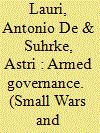

|
|
|
|
|
| Summary/Abstract |
This article examines the genealogy and behavior of the CIA militias in Afghanistan against the backdrop of persistent armed governance whereby a plurality of actors competes over control and rule. The nonaccountable use of force by militias and their volatile alliances increase the extent of armed governance, exacerbating issues of human rights abuses and undermining the possibility of future claims for justice. We discuss the effects of recurrent political violence on the peace talks and the implications for a sustainable peace, the need to include a solution for the role of militias in a peace agreement, and the necessity of ending impunity.
|
|
|
|
|
|
|
|
|
|
|
|
|
|
|
|
| 2 |
ID:
081575
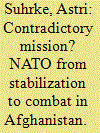

|
|
|
|
|
| Publication |
2008.
|
| Summary/Abstract |
Between 2001 and 2007, the United States and NATO gradually abandoned the commitment to a light military footprint in Afghanistan, initially adopted to avoid making the same mistakes as the Soviet Union. A heavy footprint, it was feared, would enable the militants to mobilize resistance in the name of Islam and Afghan nationalism. As it turned out, the militants mobilized effectively to meet the growing foreign military presence. More combat troops have given NATO some tactical victories, but the limitations and counterproductive effects of the military approach to defeat the militants tend to undermine NATO's broader stabilization function in Afghanistan, thus pointing to a fundamental contradiction in the mission. Strengthening NATO's combat role is likely to sharpen this contradiction and increase the related probability of a strategic failure.
|
|
|
|
|
|
|
|
|
|
|
|
|
|
|
|
| 3 |
ID:
039773
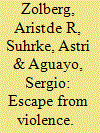

|
|
|
|
|
| Publication |
New York, Oxford University Press, 1989.
|
| Description |
xiii, 380p.
|
| Standard Number |
0195053926
|
|
|
|
|
|
|
|
|
|
|
|
Copies: C:1/I:0,R:0,Q:0
Circulation
| Accession# | Call# | Current Location | Status | Policy | Location |
| 031151 | 362.87091724/ZOL 031151 | Main | On Shelf | General | |
|
|
|
|
| 4 |
ID:
137142
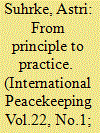

|
|
|
|
|
| Summary/Abstract |
During its engagement in Afghanistan, the US military seriously tried to mitigate the risk of civilian casualties from airstrikes only when called for by changes in military doctrine emphasizing the need to gain the support of the population. Consistent efforts by external political and humanitarian actors to reduce casualties by demanding more transparency and clearer lines of accountability for ‘collateral damage’ had little immediate, observable effect. The case study underlines the contingent nature of progress towards protecting civilians in armed conflict even when a military institution formally accepts the principles of customary international humanitarian law, but concludes that, faute de mieux, strategies to enhance protection through greater accountability and attention to the kind of military ordinance used remain central.
Over time there have been significant advances in international humanitarian law to strengthen the protection of civilians during armed conflict, and, as Adam Roberts notes, ‘in practice something has been achieved’.1 The record of the US military forces in Afghanistan after 2001, however, underlines the element of contingency in this development. During more than a decade of combat engagement in Afghanistan, the US military operated in a context of customary international law that was formally observed, but measures to reduce the impact of military operations on civilians varied significantly in practice. Only in two short periods did the USA or joint ISAF (International Security Assistance Force) command adopt practices to seriously mitigate the risk of civilian casualties. What explains this variation over time, and what does it tell us about the influence of legal norms on the belligerent?
Civilian casualties produced by US airstrikes produced the vast majority of casualties attributed to allied operations in Afghanistan. Authoritative sources reported almost 2,000 were killed and many more injured in the period 2006–13 (see Table 1).2 The US military and ISAF considered the civilian deaths as incidental damage – the unfortunate, accidental effects of war. Yet as Neta Crawford has argued, these effects were systemic in nature.3 They were ‘normal accidents’ in the sense originally developed by Charles Perrow: the predictable outcome of a flawed system design.4
|
|
|
|
|
|
|
|
|
|
|
|
|
|
|
|
| 5 |
ID:
158004
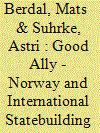

|
|
|
|
|
| Summary/Abstract |
The article examines the findings of the Commission of Inquiry established by the Norwegian government in 2014 to evaluate all aspects of Norway’s civilian and military contribution to the international operation in Afghanistan from 2001 to 2014. Concerned with the wider implications of the Commission’s findings, it focuses on two issues in particular: (1) Norway’s relations with the US, a close and long-standing strategic ally whose resources, capabilities and dominance of decision-making dwarfed that of all other coalition partners in Afghanistan; and (2) Norway’s record in the province of Faryab, where, from 2005 to 2012, a Norwegian-led Provincial Reconstruction Team was charged with bringing security, good governance and development to the province. How Norway prioritised and managed relations with the US highlights and helps to problematise the challenges – political, practical and moral – facing small and medium-sized powers operating in a coalition alongside the US. Norwegian efforts in Faryab are revealing of the dilemmas and contradictions that plagued and, ultimately, fatally undermined the international intervention as a whole. As such, Norway’s experience provides a microcosm through which the inherent limitations of the attempt to transfer the structures of modern statehood and Western democracy to Afghanistan can be better understood.
|
|
|
|
|
|
|
|
|
|
|
|
|
|
|
|
| 6 |
ID:
047221
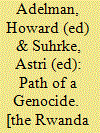

|
|
|
|
|
| Publication |
New Brunswick, Transaction Publishers, 2000.
|
| Description |
xix, 414p.
|
| Standard Number |
1560003820
|
|
|
|
|
|
|
|
|
|
|
|
Copies: C:1/I:0,R:0,Q:0
Circulation
| Accession# | Call# | Current Location | Status | Policy | Location |
| 044762 | 320.967571/ADE 044762 | Main | On Shelf | General | |
|
|
|
|
| 7 |
ID:
181186
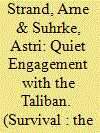

|
|
|
|
|
| Summary/Abstract |
The international response to the Taliban's sudden assumption of power in Kabul will make a critical difference for future developments in the country. Among the range of choices, a strong case can be made for engagement, dialogue and assistance. Immediate humanitarian need and widespread extreme poverty warrant substantial aid, including funds to maintain basic programmes established over the past two decades in health and education. The experience of international organisations working in Afghanistan during Taliban rule in the late 1990s constitutes a constructive precedent. Cooperation over aid is also an opening for a dialogue in which wider concerns can be aired. As in the late 1990s, sanctions and international isolation are likely to prove counterproductive by harming the Afghan people and strengthening the hardline factions of the Taliban.
|
|
|
|
|
|
|
|
|
|
|
|
|
|
|
|
| 8 |
ID:
079686
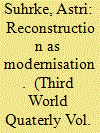

|
|
|
|
|
| Publication |
2007.
|
| Summary/Abstract |
This paper examines the post-war reconstruction programme in Afghanistan, arguing that it contains the seeds of radical social change. The paper analyses the tensions of the present reconstruction project in light of the past experience of similar programmes launched by Afghan rulers and their foreign supporters. The central argument is that the conflation of post-war reconstruction with a broader agenda for development and modernisation has brought out a wide range of tensions associated with social change. Simultaneously the prominent foreign role in the undertaking has increasingly had negative effects. As a result, the entire project shows signs of severe contradictions that are adding to the problems caused by the growing insurgency.
|
|
|
|
|
|
|
|
|
|
|
|
|
|
|
|
| 9 |
ID:
124147
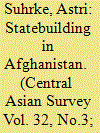

|
|
|
|
|
| Publication |
2013.
|
| Summary/Abstract |
This article lays out a critical perspective on statebuilding in Afghanistan after 2001, arguing that the massive international intervention had inherent contradictions which undermined the prospect of creating an Afghan-owned, liberal new order. Tensions related to the rentier-state condition, local ownership versus international control, and building peace while waging war are examined in detail. It follows from this analysis that the scaling-back of the international presence, now in process, is a necessary precondition for more accountable, autonomous, and sustainable statebuilding. The transition itself may be violent, with intensified competition for power and over new sources of rent. Yet it opens up new space for the Afghans themselves to re-establish a functioning and legitimate state, based on long-term bargains between elites and subjects and a measure of compromise among contesting ethnic and sectarian groups.
|
|
|
|
|
|
|
|
|
|
|
|
|
|
|
|
| 10 |
ID:
115323
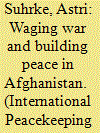

|
|
|
|
|
| Publication |
2012.
|
| Summary/Abstract |
Visions of peace and the means of violence have been strategically joined at the very foundation of the international engagement in Afghanistan since 2001. The two forces have sustained each other - peacebuilding efforts have generated legitimacy and political support for the war - but the violence has also undercut efforts to create structures of peace and prosperity, thus hastening the international search for an exit. The contradictions between simultaneously waging war and building peace in Afghanistan were recognized too late, or not at all, in international peacebuilding circles. During the early phase of the intervention, in particular, the aid and rights communities were vocal advocates for a strong international military presence. The discourse on 'security' as a prerequisite for development and peace has continued to mask the underlying tensions in the security-peacebuilding nexus as they appear in Afghanistan's internationalized civil war.
|
|
|
|
|
|
|
|
|
|
|
|
|
|
|
|
| 11 |
ID:
076735


|
|
|
|
|
| Publication |
2007.
|
| Summary/Abstract |
It is often said that a country that has experienced civil war has nearly a 50 per cent risk of sliding back into war within five years. This has been widely cited in the academic literature and in policy debates, including in UN documents and preparatory work for the establishment of the UN Peacebuilding Commission. A closer examination of the origins, circulation and establishment of this figure gives a glimpse into the process whereby academic findings are converted into conventional wisdom and effectively inserted into the policy debate, even though the findings themselves are unstable. In this case, the authors of the original figure revised their initial 50 per cent estimate down to around 20 per cent only four years after their first study, but the change was barely noted. This article examines the process whereby the findings were made, and offers a note of caution about the wholesale adoption of such figures by policymakers and academics.
|
|
|
|
|
|
|
|
|
|
|
|
|
|
|
|
| 12 |
ID:
192973
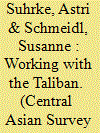

|
|
|
|
|
| Summary/Abstract |
Nearly two years after the Taliban seized power in Kabul, in August 2021, the international aid community continued to search for workable approaches to deal with the new situation. Afghanistan’s deepening economic and humanitarian crisis called for major assistance, but the relationship between major donors and the Taliban de facto authorities had settled into a deeply adversarial mode. It resembled in many respects the relationship between the international aid community and the Taliban during the first Emirate (1996–2001). The story of that limited and difficult interaction – mostly consisting of humanitarian aid in a process that swung between confrontation and creative, though modest, compromises – is worth recalling for the insights it holds for the present. This article examines the patterns of that interaction, the results on the ground and the implications for the Western relationship with the present Taliban Emirate.
|
|
|
|
|
|
|
|
|
|
|
|
|
|
|
|
|
|
|
|
|